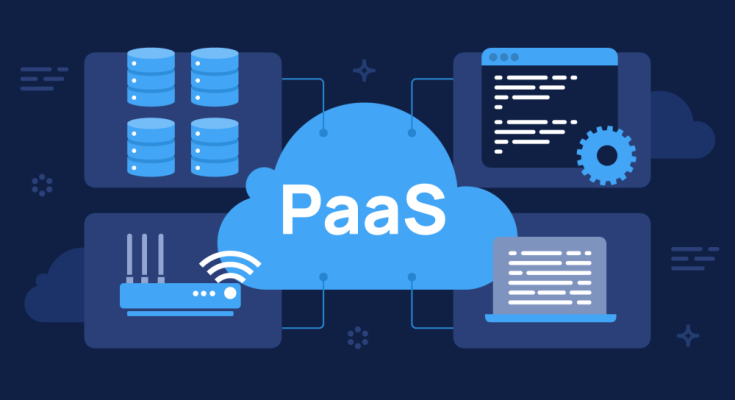The PaaS (Platform as a Service) is a cloud computing concept that allows users to rent software and hardware via the internet. This makes it simple to create software and apps rapidly. Developers commonly use PaaS. It allows people to create, build, and run programs without worrying about infrastructure. PaaS allows users to manage and control cloud infrastructure. This covers servers as well as storage. They can, however, control app deployment and configuration settings. Google Cloud’s prominent PaaS services include Amazon Web Services (r) Elastic Beanstalk and Google App Engine. A Cloud Computing Service Platform enables clients to create, secure, manage, and run web apps. It lets teams create and deploy apps without needing to manage IT infrastructure. The platform gives developers and users Internet access while supporting the whole software development life cycle. The advantages of PaaS include simplicity, cost savings, and flexibility.
How To Easily Secure Platform As A Service (PaaS Environments)?
PaaS is more secure than a data center on-premises. Security measures protect PaaS settings. PaaS customers have security measures to protect their platform accounts, data, and apps. Identity perimeter security would, in an ideal world, replace premise security. The key security boundary for the PaaS client should be identical. Authentication, monitoring, logging, operations, and logging are required to protect code, data, configurations, and operations.
Apps To Protect Against Common And Unknown Threats
The best way to protect oneself is to use an automated security system that detects and stops any assault. Users of PaaS can also take advantage of the platform’s security features and third-party solutions. Unauthorized access, attacks, and breaches must all be identified and prevented swiftly. In addition, you must be able to identify harmful bots, hostile users, strange logins, takeovers, and other abnormalities. Security is an important part of technology.
Keep App And User Resources Protect
Every contact may be considered as an assault surface. Therefore, it is important to limit or limit untrustworthy persons’ access to resources and vulnerabilities. This will aid in the prevention of attacks. To reduce vulnerabilities, security systems must be patched and upgraded regularly. The service provider does not protect the platform. However, it is the client’s responsibility to assure security. Add-ons and third-party solutions, for example, can greatly increase account, app, and data security. Only authorized personnel and users have access to the system.
Another option is to restrict administrative access and set up an audit system to create possibly risky behavior by external users and internal teams. Administrators should limit the rights provided to users as much as feasible. To guarantee that programs and other operations are carried out appropriately, users should be provided as minimal rights as feasible. As a result, the attack surface is reducing, and privileged resources are becoming more vulnerable.
Use The App To Look For Security Issues
Apps and libraries’ security vulnerabilities and risks are evaluated. The findings can be used to enhance component protection. Daily screening may be automated in an ideal world based on app security risks and sensitivity. When a security danger or attack is discovered, you should include a solution that can be integrated into other tools such as communication software or used to warn the necessary personnel.
Analyze And Offer Suggestions On Security Risks Associated With Addiction
Apps use open source needs in both direct and indirect ways. If addressed, these flaws might render an app safe. Validating third-party networks and testing APIs necessitates an analysis of the program’s internal and exterior components. All of these solutions are effective at resolving the issue.
Pentesting And Threat Modelling
Penetration testing finds and corrects security flaws before attackers exploit them. The Penetration testing might appear aggressive, similar to DDoS attacks. To prevent false alarms, security staff must collaborate. The simulation of attacks from trustworthy boundaries is known as threat modeling. This allows attackers to take advantage of design faults. IT teams may strengthen security and identify and address any vulnerabilities or risks.
Keep Access Of User And File Access
By controlling privileged accounts, security teams can monitor how users interact with the platform. It allows security teams to identify whether certain user behaviors risk safety or compliance. For example, examine and record user permissions before filing activities. This keeps track of unlawful access, modifications, downloads, and uploads. Likewise, file activity monitoring systems should record all users who open a file. A good solution will detect several unsuccessful login attempts, suspicious behavior, and suspicious activities. Likewise, logging in at unusual hours, downloading potentially harmful stuff, and so forth. These security systems alert security professionals to security problems and suspicious activity.
Data Access Restrictions
The ideal option is to encrypt data during storage and transfer. Human attacks can also be prevented by securing Internet communication channels. Set HTTPS to encrypt and secure the channel and data with TLS.
Always Double-check The Data
This guarantees that the input data is secure and correctly formatted. All data from an external security team or internal users must be considered high-risk. Client-side validations must be performed correctly to prevent malicious or compromised files from being submitted.
Vulnerability Code
Analyze the vulnerability code during development. Developers should wait to put the app into production until the code has been thoroughly tested.
MFA Enforcement
Only authorized users may access data, apps, and systems thanks to multi-factor authentication. For example, you can use a password, OTP, or SMS to access your mobile app.
Password Security Should Be Enforced
Many people use weak passwords that are easy to remember and are seldom updated. Administrators can mitigate this risk by enforcing strict password requirements. It is important to choose secure passwords that do not expire. Encrypted authentication tokens, credentials, and passwords are better than plain text credentials.
Authentication And Authorization
OAuth2 and Kerberos authentication and permission protocols are permitted. Although it is doubtful that unique authentication codes would not expose systems to hackers, they can still be misused.
Management Necessities
Predictable cryptographic keys should be avoided. Instead, use secure distribution techniques to cycle keys often, renew keys on time, and prevent hardcoding in apps. Key rotation that is automated increases security and compliance while lowering data exposure.
App Access And Data Control
You must create an auditable security policy with rigorous access controls. It is preferable to limit access to authorized users and personnel.
Log Collection And Analysis
All data, including system logs, APIs, and apps, can be beneficial. Automated log gathering and analysis can also give useful data. Logging services are available as add-ons or as built-in capabilities. They are excellent for assuring compliance with security laws. Log analyzers may interface with your alert system, assist your technical stacks, and create a dashboard.
Keep A Record Of Everything
This covers unsuccessful login attempts, password changes, and other account-related events. A robotic technique can also be used to halt questionable or unsafe counter-activity.
The Bottom Line:
The consumer or subscriber is now responsible for the security of an account, data, or app. This necessitates a different security strategy than typical on-site data centers. When creating apps that provide proper security both inside and outside, safety must be considered account. Log analysis shows security weaknesses and places for improvement. Security teams would spot vulnerabilities and risks before attackers in a perfect world.



